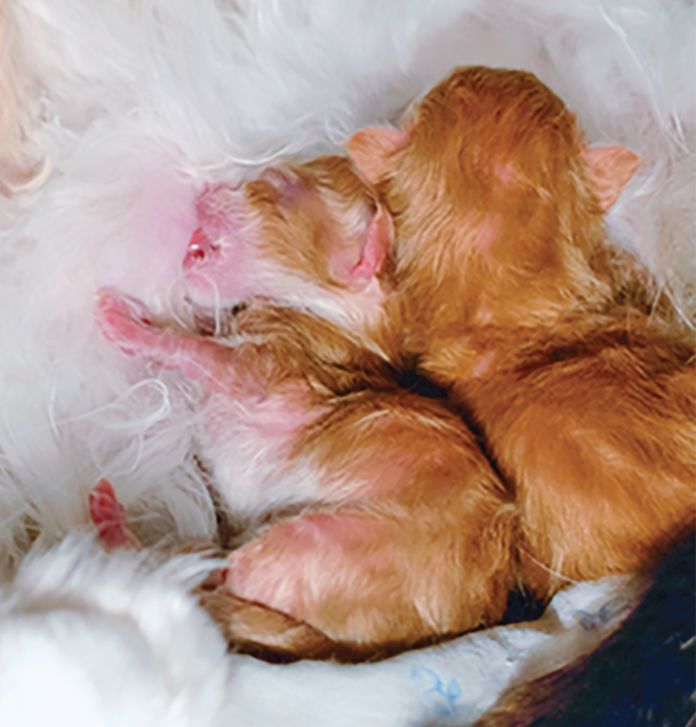Amazing as it may sound, kittens born with a different blood type from their mother are at risk of death. In this condition, called neonatal isoerythrolysis, the mother’s antibodies attack the kittens’ red blood cells, and the newborn kittens can die.
Blood Types Matter
Cats have three blood types (see sidebar) that are associated with naturally-occurring antibodies against “foreign” blood types. Type A cats have antibodies against Type B blood cells, and Type B cats have strong antibodies against Type A (these antibodies will also attack Type AB cells).
In neonatal isoerythrolysis, the antibodies from a queen’s colostrum (first milk) attack the kitten’s red blood cells, causing anemia and death. Marjory Brooks, DVM, DACVIM, Senior Research Associate in the Department of Population Medicine and Diagnostic Sciences at Cornell, says, “The Type A kittens produced from mating Type B queens to Type A males are at risk for neonatal isoerythrolysis.”
First 24 Hours of Life
Colostrum is rich in nutrients and also contains antibodies. These antibodies are important because newborn kittens have immature immune systems, so they need their mothers’ antibodies to fight diseases that they may be exposed to until their own immune systems at work.
When kittens drink colostrum, the queen’s antibodies are absorbed through the digestive tract into the kitten’s bloodstream for the first 12 to 24 hours of life. After this time, their digestive tracts “close” and no longer allow antibodies from the queen to be absorbed. If a kitten is Type A or AB and drinks colostrum from a Type B queen before gut closure, that kitten will absorb anti-A antibodies from the mother into its bloodstream, where the antibodies can wreak havoc on the kitten’s red blood cells.
Signs and Symptoms
Dr. Brooks describes the typical neonatal isoerythrolysis case as a “Fading kitten, with poor nursing, weak, pale or jaundiced mucous membranes, and discolored (brown) urine.” If blood work is done, it will show anemia (a low red blood cell count).
These kittens usually appear healthy at birth but begin to show clinical signs within a few hours or up to several days old. Severity and time of onset may vary depending on how many antibodies are absorbed into the kitten’s bloodstream.
Prevention and Treatment
Of course, prevention is the best approach. “Exact prevalence is unknown, and varies widely depending on the frequency of Type A and Type B cats within a breed or geographic region,” says Dr. Brooks. For certain breeds, including the British Shorthair, Devon Rex, Persian, Abyssinian, and Turkish, blood typing should be a routine part of pre-breeding health screening to select appropriate mates, and it isn’t a bad idea for cats of any breed or mix.
“Prevention by blood typing before breeding is much better than treating after the fact,” advises Dr. Brooks. Getting your cat blood typed is a simple process that many clinics can do in-house.
Unfortunately, most kittens in the United States do not have a responsible breeder watching out for them. If you take in a pregnant cat or find that your young cat is auditioning for “Teen Mom,” you can still have her blood typed. If the queen is Type A, there are unlikely to be problems regardless of who the sire is, but if she is Type B there is risk.
If you know that the female cat is Type B and either know that the male is Type A or suspect that he is (based on the fact that Type A is more common), Dr. Brooks says, “The kittens should not ingest colostrum from the Type B queen for the first day or two.”
Separate the kittens from their mother immediately after birth. Ideally the kittens should be put with a Type A foster mother at least temporarily to allow them to absorb antibodies (there are antibodies in regular milk, just not as many as in colostrum), but kitten milk replacer can also be used.
Extra care needs to be taken with kittens started out on kitten milk replacer, as they will not have any maternal immunity and are at higher risk for illness. Once the kittens have crossed the 24 hour mark for gut closure, they can be safely returned to the care of their Type B mom.
If kittens show signs of neonatal isoerythrolysis, immediate veterinary intervention is necessary. “Severe cases may require transfusion for anemia and other supportive care with milk replacer, fluids, oxygen,” says Dr. Brooks. “Mortality rate is high.” All kittens in the litter should be monitored closely.
Feline Blood Types
In cats, Type A is the most common blood type, found in as many as 99% of domestic cats in the United States. The Type A allele (form of a gene, for which there are two alleles, one from each parent) is also dominant, so a cat only needs one copy of that allele (i.e., from one of its parents) to be Type A.
Type B is the second-most common, most often found in purebred cats such as the British Shorthair, Devon Rex, or Cornish Rex. Prevalence of the Type B blood type in domestic shorthairs and longhairs varies by region, with the Northwest having the most Type B cats.
Type AB, which is not a combination of A/B blood types, is a unique allele and the most rare blood type.
Did You Know?
Big cats have the same blood types as our domestic cats. So lions, tigers, and cheetahs are also at risk for neonatal isoerythrolysis if Type A kittens are born to Type B mothers.



